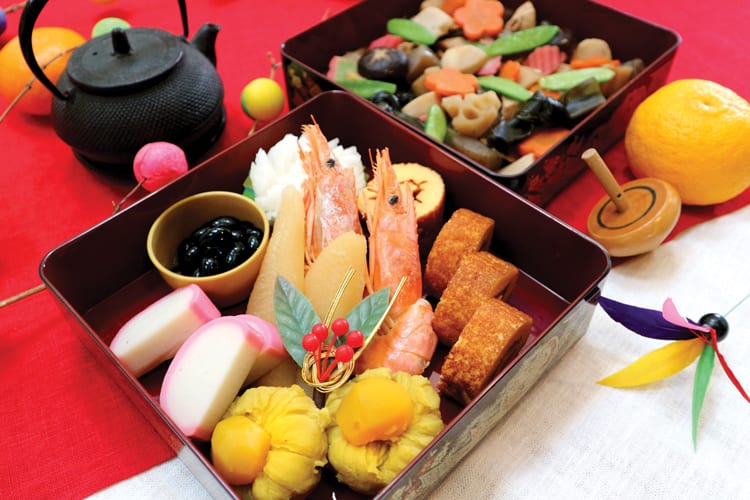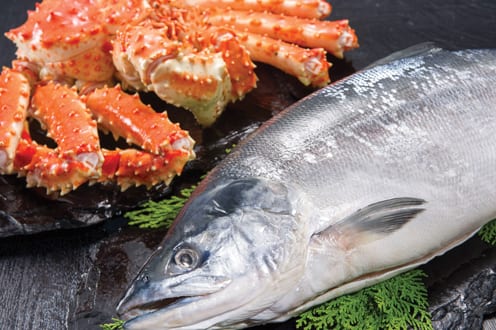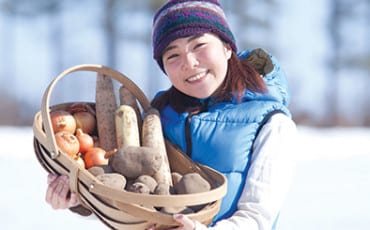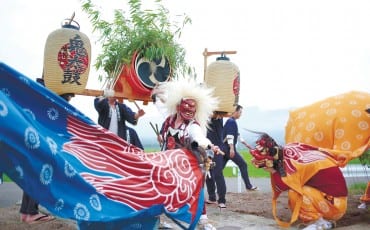Articles
Seasons
Jan 9, 2019
New Year, New Tastes
Winter may have arrived in Japan but we can still look forward to many delicious and celebratory foods of the season.

When the temperature drops, it’s the time to harvest hardier crops like citrus fruit and root vegetables. These ingredients would have reached their peak freshness and flavour, or what is known in Japan as “shun”.
Sour and sweet citrus fruit is gathered in early winter, like the popular yuzu, a small, yellow citron with a bright, refreshing fragrance. Its piquant zest is commonly used in cooking, such as soups and simmered and steamed dishes. A few leafy vegetables are another must-try during winter. These include komatsuna or mustard spinach, rich in calcium and a favourite of the season, and mizuna, which is often sautéed with chicken or pork, or simmered in a hot pot dish.
Most root vegetables have their shun in winter. Daikon radish, one of Japan’s most fundamental ingredients in Japanese cooking, is usually served grated and raw as daikon oroshi, or used in stews and simmered dishes like oden. Not to be confused with daikon, kabu or turnip is also widely eaten in winter, and used in tsukemono or miso soup.
Beyond fruit and vegetables, fish and shellfish also have their seasons too. Freezing waters mean a profusion of fish that have accumulated fat for the winter. Tastier and more flavourful, these fattened fish include cod (tara), yellowtail (hamachi), and mackerel (saba). Plump sea bream (tai) is especially enjoyed in winter and often served in celebratory dishes for the New Year.
Of course, there are plenty of shellfish to savour during this season, such as shrimp (ebi) and asari or hamaguri clams. But the ultimate winter delicacy in Japan is surely crab, particularly female egg-bearing crabs. Especially sought after are zuwaigani or Pacific snow crab, caught off the coast of the Sea of Japan and eaten grilled, steamed, or raw as sashimi.
Celebrating the New Year

The arrival of winter also means the New Year will soon be upon us. Ask any Japanese and they will tell you that New Year or oshogatsu is the most important holiday in Japan. Before the big day, families will prepare the mochi (pounded rice cakes) and osechi ryori, traditional Japanese food to be served at the New Year.
Beautifully presented in lacquered bento boxes, osechi ryori is prepared by New Year’s Eve and placed on the dining table to be shared by loved ones. Inside these boxes, you will find several symbolic foods, often using shun ingredients and each representing a wish for the new year.
For example, grilled sea bream symbolises auspiciousness and celebration. Pickled turnip, served in the shape of chrysanthemums (kiku), represents good wishes. The auspicious red and white colours of namasu, a vinegared daikon and carrot salad, are a good omen. And steamed, bright red shrimp and crab signify longevity and good fortune respectively.
Served alongside osechi ryori is a special mochi soup called ozoni, which is often prepared with chicken, daikon and komatsuna, and garnished with yuzu zest. Although ozoni comes in many regional variations, it is always eaten on the morning of 1 January to usher in the New Year.
Yes, winter in many parts of Japan can be cold, dark and long, bringing snow, sleet and ice. But kitchens warm up with the simmering and stewing of everyday as well as special New Year dishes that use shun produce and seafood. And these comforting meals are always shared among friends and family, making them the perfect antidote for chilly, grey days.

A Postcard from Japan
“Asahiyama Zoo is one of Japan’s most well-known zoos as the animals thrive in their natural surroundings. The penguin parade is the highlight of any visit during winter. The adorable penguins waddle and display their playful antics in front of visitors. The walk is designed to keep them fit and healthy!” −Oishii reader Wendy Ng
(TEXT Denyse Yeo )








